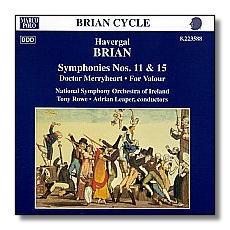
The Internet's Premier Classical Music Source
Related Links
- Brian Reviews
- Latest Reviews
- More Reviews
-
By Composer
-
Collections
DVD & Blu-ray
Books
Concert Reviews
Articles/Interviews
Software
Audio
Search Amazon
Recommended Links
Site News
 CD Review
CD Review
Havergal Brian

Symphonies #11 & 15
- Symphony #11 *
- Symphony #15 **
- Concert Overture "For Valour" **
- Comedy Overture "Doctor Merryheart" *
* National Symphony Orchestra of Ireland/Adrian Leaper
** National Symphony Orchestra of Ireland/Tony Rowe
Marco Polo 8.223588
In 1990, the music of Havergal Brian (1876-1972) was making quite a splash, as several recordings of his music had recently appeared and an important première issue had come out that summer, the massive choral First Symphony, the so-called Gothic. In fact, it was released on this label, then called Marco Polo/Records International, which at the time was distributed by Harmonia Mundi. This recording is still available in Marco Polo's ongoing Brian series, but, as most know by now, is distributed by its sister-company, Naxos. Since that time a good many more of his thirty-two symphonies and other works have received attention on disc, if not in the concert hall. Now in the wake of numerous re-discovered and altogether new composers, Brian's rising star has come back down to earth.
Yet, his art must still be assessed as it was a decade or so ago: here was an unjustly neglected composer, whose complex musical forms and prolific output in later years set him apart from his contemporaries. The best way to describe him, though – or, at least, his musical attitude – is simply to say he was a one-of-a-kind figure, content to go his own way and not care what trends he might have been expected to follow.
The music on this disc is well-crafted, with even the overtures invested with fine music and adroit orchestration. They are not fluff and each, especially Doctor Merryheart, offers much color and substance in a style vaguely reminiscent of Vaughan Williams. The symphonies, though, are the truly important items here.
The 1954 Eleventh starts off with an Adagio of great beauty, simplicity, complexity and timelessness. That string of adjectives may abound in contradiction, but it's hard to describe what you are listening to here: at times, the music carries strains of Rachmaninoff, Mahler, Ives, and even of Hanson. Yet, in no way does it imitate the music of those composers. The long second movement is colorful and seemingly episodic, though after repeated hearings things tend to appear more unified than they had at first. This is not to suggest that his expressive language here is dense or unapproachable; rather, it is subtle and rich in ideas. Some sections, especially in the latter half of this movement, have an exoticism that is reminiscent of the weird colors in Vaughan Williams' Eighth Symphony, though any further similarity between the two works isn't to be noticed. The finale is short and colorful, again showing an exotic side. This generally playful and celebratory music caps off an interesting and attractive symphony that fully deserves greater attention.
The 1960 Fifteenth Symphony begins in a festive mood and is optimistic throughout. It seems that whenever Brian becomes celebratory, his music divulges a British pageantry and more than vaguely suggests Vaughan Williams. In the middle part of this one-movement work there is some ponderous yet colorful music, that features some very interesting and delicate writing in various passages for reeds, horn and celesta. Brian turns exotic once more in the latter pages of the score, the atmosphere becoming something akin to slow-motion Spanish music. In the end, this, too, is a worthy symphony from the pen of one of the most interesting and still-underrated composers of the 20th century.
The performances here are quite convincing. This Irish orchestra has turned in some fine work for the late Georg Tintner in his Bruckner cycle and for Adrian Leaper in Sibelius. Both conductors here seem to have a feel for the unique idiom of Brian and offer incisive readings in all works. The profuse notes by Malcolm Macdonald, who has written extensively about Brian, are among the most brilliant and informative I've encountered. If only all labels could offer the same scholarship in their notes.
Copyright © 2000, Robert Cummings


















